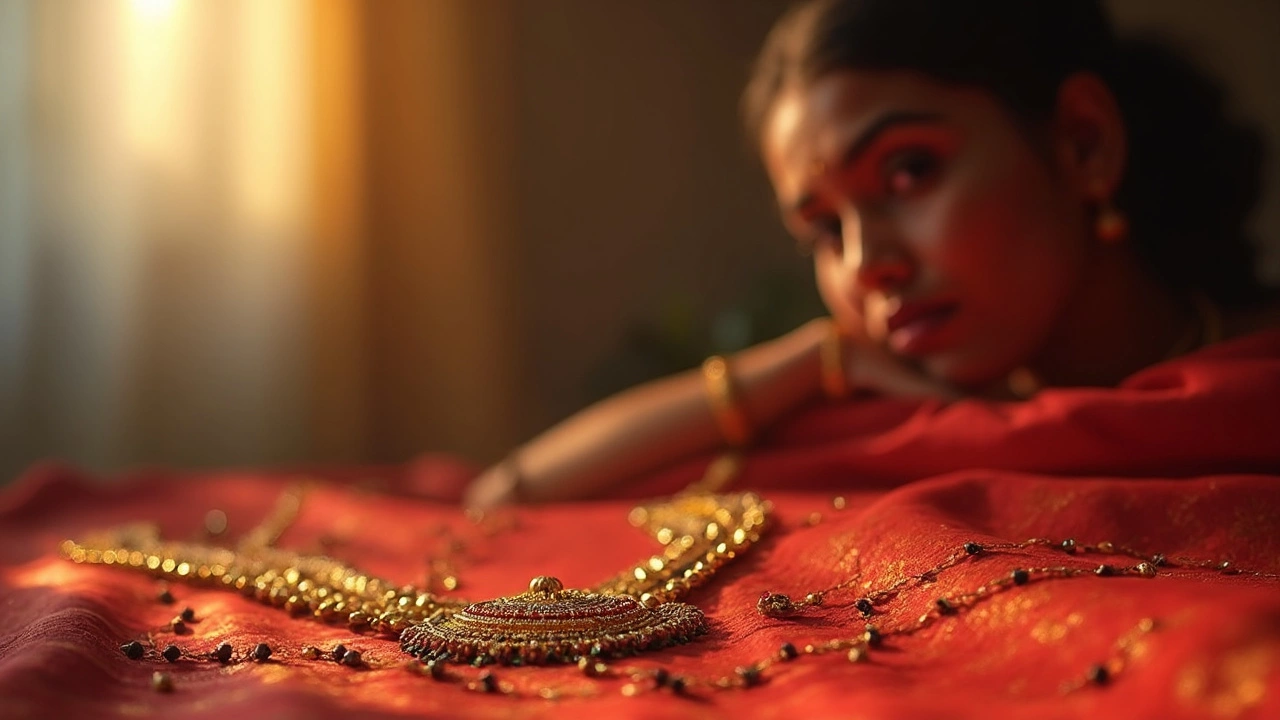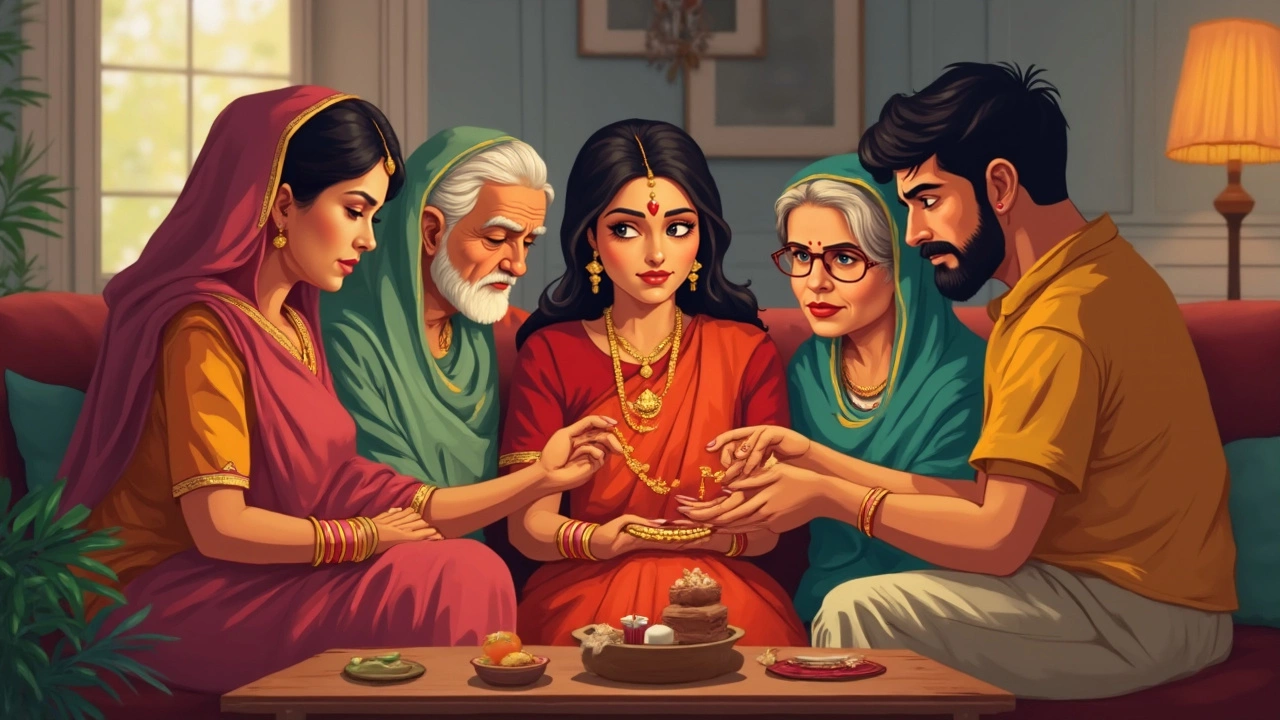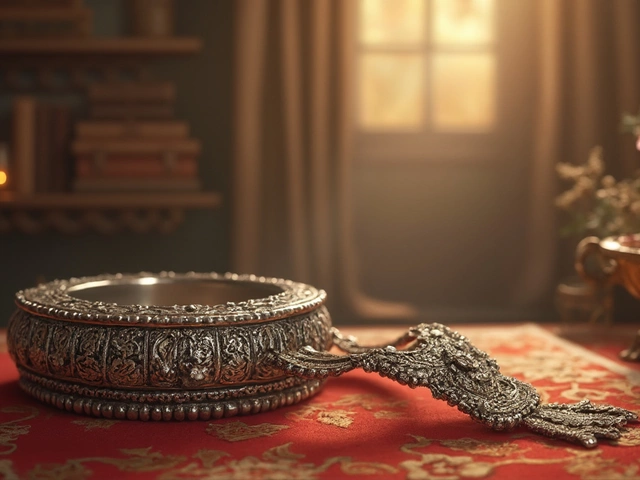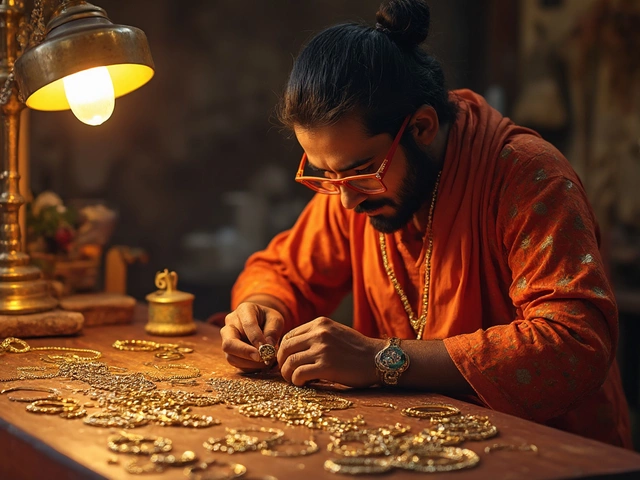
You’d be surprised how a single broken chain, a snap of black beads tinkling on the floor, can fill a room with gasps and a hundred worried whispers. For many married Hindu women, a mangalsutra isn’t just another piece of jewelry—it’s loaded with emotion, customs, and superstitions that go back centuries. It’s not rare for people to freak out if it breaks, but is that worry justified? Or is it just a mix of ancient tales, coincidence, and a bit of old-fashioned drama?
The Deep Symbolism of the Mangalsutra
The mangalsutra is not just a necklace. It's a powerful marital symbol in Hindu culture, often considered as important as the wedding ring in many Western traditions. Made of black beads on a gold chain, sometimes with added diamonds or pendants, it’s always given to the bride by the groom during the wedding ceremony. The ritual, called “mangalya dharanam,” is the heart of most Hindu marriage rites. It literally means “wearing the auspicious” and is seen as the very moment when two lives become linked.
Each part of the mangalsutra tells a story. The black beads are said to keep evil spirits away, protecting the bond between wife and husband. Gold represents prosperity and luck. Some regions, especially in South India, have elaborate mangalsutras with multiple strands, while in North India, the designs are sleeker. But everywhere, the main idea sticks: it’s a sign that a woman is married, a holder of her partner’s good fortune, and a visible guard against negative forces.
But it’s not just about what people see. In many homes, women carry a deeply personal connection with their mangalsutra. They’ll touch it in times of stress, or as a habit before leaving the house, feeling its weight as both comfort and responsibility. Some see it as spiritual armor, or even a gift passed down between generations, adding another layer of emotional value.
Here’s a cool fact: A mangalsutra’s exact design changes depending on community and region. Some Maharashtrian brides wear a ‘vaati’ style; Tamil brides favor ‘thali’ in gold thread; Andhraites might use coral or unique symbols. No two are exactly the same, and sometimes, family traditions govern how the mangalsutra is to be renewed, replaced, or maintained. That malleability keeps the tradition alive, even for modern couples who go for minimal, Western-influenced versions–though the original meaning never really goes away.
Official stats on the monetary value of mangalsutras in India are hard to pin down, but estimates indicate that the wedding jewelry industry is worth $50 billion annually in the country. Even as youngsters get more liberal, about 90% of Hindu weddings still include a mangalsutra ritual, according to a 2023 survey from the Pune-based Indian Social Cultural Forum.
Why Does a Mangalsutra Break? Superstitions vs. Real Reasons
The audible sound of beads hitting the floor has sparked plenty of tension in living rooms. Superstitions fly fast. Many believe that a broken mangalsutra might signal impending bad luck, danger to the husband, or evil spirits lurking close by. This stems from a very old fear that anything threatening the marital bond might also threaten a husband’s life.
Some families even have their own scary warnings—like a grandmother swearing that a mangalsutra broke before a relative had an accident, or a neighbor retelling tales of a bead lost minutes before receiving bad news. Small wonder people panic. But does breaking really mean disaster is on the way?
Let’s clear the fog. Practically, mangalsutras break for physical reasons. Here’s a table with a few common causes:
| Reason | Description |
|---|---|
| Wear and Tear | Chains get thin, clasps loosen, beads slip out over years of daily use. |
| Accidental Tugging | Hair pulls, kids yanking, or getting caught on clothes, bags, or door handles. |
| Poor Craftsmanship | Inferior quality metal or beads make the necklace more fragile. |
| Exposure to Chemicals | Perfume, soap, or cleaning agents can weaken the gold or string. |
| Sleep Habits | Sleeping with the necklace on can bend or twist delicate parts. |
No ancient spell here, just everyday mishaps. In fact, jewelers report that fixing broken mangalsutras is one of the top requests from married clients. According to a 2022 report by Jewelers Association of India, about 1 in 5 married women have needed their mangalsutra repaired at least once in their lives. And sometimes, it’s just about bad luck—yes, the ordinary kind.
Yet, belief systems are strong. Telling family that a break is just physics can feel pointless amidst all that inherited anxiety. Many households stick to their rituals—some burn incense, chant mantras, or even do a small puja to "wash away" whatever ill omen they fear has arrived. In some places, people might rush to a temple with the broken mangalsutra to get a priest’s blessing before fixing it.
However, more and more couples—especially in cities—see the mangalsutra as a bond of love, not a barometer of life and death luck. They might laugh it off, use it as a reason to upgrade their jewelry, or see it as an excuse for a date night while shopping for a replacement.

Traditions, Beliefs, and the Influence of Family
The way families react when a mangalsutra breaks depends a lot on where you are in India, as well as the local culture and the elders at home. In some strict houses, a woman might be asked to fast, do extra prayers, or stay away from celebrations until her mangalsutra is fixed. Things get especially intense if the break happens close to festivals like Karwa Chauth, Teej, or during an eclipse—times loaded with symbolism about marital well-being.
Some South Indian traditions demand that not just the wife, but the husband too, should fast or pray if the sacred chain snaps. In Andhra and Tamil Nadu, people might call the extended family, seek advice from the priest, and even schedule a mini-wedding ritual to “rebind” the lucky thread. There are detailed steps for washing, blessing, and replacing every single bead that falls off.
But it’s not all rules and omens. In more easy-going homes, the event passes with a shrug, a joke, or a self-deprecating smile about being clumsy. Especially among younger couples in places like Mumbai, Delhi, or Bangalore, there's a growing belief that what matters is the bond, not the chain. Couples sometimes build new rituals of their own, treating a broken mangalsutra as a reminder to take care of each other, talk about their relationship, or simply focus on what matters.
So, if your mangalsutra breaks and you’re worried about family blowback, it helps to know your household’s outlook. If your parents-in-law lean traditional, a little ceremony, visiting a temple, or observing fasts could put anxious minds at ease. In less ritual-heavy homes, replacing or repairing it quietly is usually enough.
One interesting tip: Some couples now keep a "backup" mangalsutra for such emergencies, especially if travel or work means the original can’t be fixed immediately. Jewelers have even started offering 'emergency' mangalsutra kits (think simple gold-plated bead strings), which women can wear temporarily if the real one is being repaired.
And here’s a modern angle—on Instagram, #mangalsutra stories have become a trend, with women sharing photos of their repaired or upgraded necklaces and swapping stories on what actually happened when theirs broke. Most report that after the fix, life marched on as usual—but families felt better for doing what felt right for them.
What to Do If Your Mangalsutra Breaks: Steps and Tips
So you’re staring at a string of black beads on the floor and wondering: Now what? First step, don’t panic. It’s natural to feel a jolt, but a broken mangalsutra doesn’t have the magical power to control your fate. Here’s what you can actually do:
- Pick Up All the Beads: Count them, save them in a safe pouch—even the tiniest ones. Lost beads can sometimes be bought and replaced by a jeweler, but originals are always preferred.
- Keep the Chain Safe: Every part, even broken, has sentimental value. Wrap it gently until it’s repaired.
- Decide on Rituals: If your family believes in purification or an offering, a visit to a temple or a small prayer at home can help set minds at ease.
- Contact a Trusted Jeweler: Get it repaired by someone who’s experienced with sacred jewelry. Ask for options—is it a simple mend, or a total replacement?
- Consider Upgrading: If the design or string keeps failing, maybe it’s time to switch to a more durable style.
- Share with Your Partner: Some husbands also wear a “kautuka” (sacred thread) on their wrist for a period if the wife’s mangalsutra breaks—making it a shared moment rather than something the woman must face alone.
- Take It Easy: Accidents happen; don’t let anxiety win. If you’re feeling superstitious, balance it with personal faith or a small mindful ritual.
- Focus on Care: To prevent repeats, keep jewelry away when doing physical work, avoid harsh chemicals, and get regular checkups/cleanings at the jeweler’s, much like you would for an engagement ring.
A fun extra tip: If you’re traveling or staying away from home for work or studies, tuck a lightweight backup mangalsutra in your luggage. Even a simple gold chain with a few beads can substitute in an emergency, letting you follow tradition and keep everyone happy back home.
For those wanting to sidestep superstition, start a new ritual of your own. Some couples leave notes for each other, redo their wedding vows, or make a donation to charity every time something “unlucky” happens. It reframes the break into an opportunity—a way to strengthen the partnership, rather than get lost in fear.
At the end of the day, a mangalsutra carries the meaning you give it. Whether you follow every tradition to the letter, blaze a new trail with your partner, or just see it as a lovely necklace, it’s your story that counts. So, if those beads ever come loose, remember: fixes are a phone call (or a jeweler’s shop) away, while the love and memories stay unbroken.


